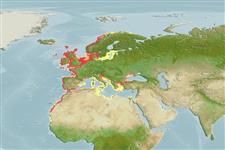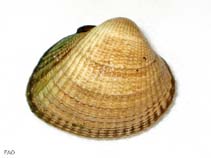Cerastoderma edule (Linnaeus, 1758)
Common edible cockle| Native range | All suitable habitat | Point map | Year 2050 |

|
| This map was computer-generated and has not yet been reviewed. |
| Cerastoderma edule AquaMaps Data sources: GBIF OBIS |
Classification / Names Common names | Synonyms | CoL | ITIS | WoRMS
Bivalvia | Cardiida | Cardiidae
Environment: milieu / climate zone / depth range / distribution range Ecology
Benthic; brackish; depth range 0 - 5 m (Ref. 125442). Subtropical, preferred 10°C (Ref. 107945); 71°N - 14°N, 17°W - 33°E (Ref. 107077)
Distribution Countries | FAO areas | Ecosystems | Occurrences | Introductions
Eastern Atlantic, the Mediterranean and Black Sea: from Portugal to Egypt, north to Norway and Russia then south to Senegal, including Mediterranean and Black Sea. Occurrence in Iran, Persian Gulf is questionable.
Length at first maturity / Size / Weight / Age
Maturity: Lm ? range ? - ? cm Max length : 5.6 cm SHL male/unsexed; (Ref. 101424); common length : 3.5 cm SHL male/unsexed; (Ref. 437); max. reported age: 7 years (Ref. 2823)
Life cycle and mating behavior Maturity | Reproduction | Spawning | Eggs | Fecundity | Larvae
Main reference
References | Coordinator | Collaborators
Fischer, W., G. Bianchi and W.B. Scott (eds.) 1981 Bivalves. 6: pag.var. In FAO species identification sheets for fishery purposes. Eastern Central Atlantic (fishing areas 34, 47; in part). Canada Funds-in-Trust. Ottawa, Department of Fisheries and Oceans Canada, by arrangement with the Food and AgriculturesOrganization of the United Nations, 1-7: pag.var. (Ref. 437)
IUCN Red List Status
(Ref. 130435: Version 2025-1)
CITES status (Ref. 108899)
CMS (Ref. 116361)
Threat to humans
Human uses
Fisheries: commercial
FAO - Aquaculture: production; Fisheries: landings, species profile | FishSource | Sea Around Us
Tools
More information
Max. ages / sizes
Length-weight rel.
Length-length rel.
Length-frequencies
Mass conversion
Abundance
Internet sources
BHL | BOLD Systems | CISTI | DiscoverLife | FAO(Fisheries: species profile; publication : search) | Fishipedia | GenBank (genome, nucleotide) | GloBI | Gomexsi | Google Books | Google Scholar | Google | PubMed | Tree of Life | Wikipedia (Go, Search) | Zoological Record



